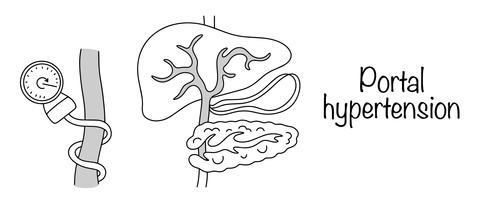Role of endoscopy in the diagnosis of clinically significant portal hypertension
Dajti E et al, J Hepatol. 2025;82(3):490-498
Non-invasive tests (NITs) cannot reliably identify the presence of clinically significant portal hypertension (CSPH) in all patients with cirrhosis. A new algorithm combining NITs and endoscopy improves diagnosis and risk stratification, particularly in cases within a grey zone. However, the addition of spleen stiffness measurements may potentially eliminate the need for endoscopy in these cases.
Background and aims: Whether non-invasive tests (NITs) can accurately select patients with cirrhosis requiring non-selective beta-blockers (NSBBs) for clinically significant portal hypertension (CSPH) and prevention of decompensation is unclear. The aim of this trial was to test the performance of NIT-based algorithms for CSPH diagnosis using the prospective PREDESCI cohort. The authors investigated whether a new algorithm combining NITs with endoscopy could improve performance.
Methods: The authors included patients with compensated cirrhosis and available liver elastography who were screened during the trial. The performance of models based on liver stiffness measurement (LSM) and platelet count was evaluated. An algorithm considering endoscopy for patients with inconclusive results (the "grey zone") was then developed and validated in an independent cohort of 195 patients in whom spleen stiffness was also available.

Results: 170 patients from the PREDESCI cohort were included. An LSM ≥ 25 kPa alone (Baveno VII criteria) or combined with an LSM > 20 kPa plus thrombocytopenia (AASLD criteria) ruled-in CSPH with positive predictive values of 88% and 89%, respectively. However, 37–47% patients fell into the grey zone while at high risk of decompensation or death. Performing endoscopy in inconclusive cases identified patients with varices that, when reclassified as high-risk for CSPH, significantly reduced the grey zone to 22%. In this algorithm, 86% of patients with CSPH were correctly classified as high risk. The diagnostic performance was confirmed in the external validation cohort, where combining Baveno VII criteria with spleen stiffness showed similar accuracy to the model using endoscopy.
Conclusions: Algorithms based only on liver stiffness measurement and platelet count are suboptimal to identify non-selective beta-blockers treatment candidates. Performing endoscopy in patients with indeterminate findings from non-invasive tests improved diagnostic performance and risk stratification. Endoscopy may be substituted by spleen stiffness for stratifying risk in the grey zone.